#long shawl scarves
Text
Buy Long Shawl Scarves for Women Near Me - Virginia Blossoms
Discover the perfect blend of style and comfort with Virginia Blossoms' exquisite collection of Long Shawl Scarves for Women. Our range offers unparalleled quality and design whether you are searching for Buy Long Shawl Scarves for Women Near Me or seeking the elegance of Silk Hair Scarves for girls. Elevate your wardrobe with our unique, human-crafted scarves, a must-have accessory for any fashion-conscious individual. Shop now at Virginia Blossoms to add a touch of sophistication to your look!
0 notes
Text

#scarves#hairstyles#shawls#prints#long blonde hair#beauty#european summer#western summers#summertime#hippie styles
13 notes
·
View notes
Text
My toxic trait is that I really love fiber arts: I love to crochet, I think handspun yarn is the coolest shit, I'm seriously considering trying wet felting someday,
But none of it fits my clothing style outside of maybe the occasional scarf or bag (tho I much prefer backpacks, so even that is shaky), sofrom the outside I still just look like I have no appreciation for handmade clothes and am all about fast fashion
#chatter tag#this is both an issue of feeling self conscious about it#and of never getting the joy of wearing stuff i made myself bc i dont like how that stuff looks on me!#i dont make clothes partially bc of that and partially bc they take really long for me to make#shawls are the farthest i go bc i like the look of them as art pieces#anyway my specific brand of insanity is just incompatible with my wardrobe of button ups/waistcoats/hoodies/beach shorts#and i dont need any more scarves! or a tote bag! i already have a tote bag its rainbow and my mum got it for me#also backpack supremacy#if one hand is holding a cane and the other hand is holding sunshines hand where am i supposed to put a bag :(#anyway. maybe someday ill make a big granny square cardigan/coat bc thats the like one crochet garment that appeals to me#howl movingcastle ass gender#but like. that is the full extent of it unfortunately#sigh okay ive just been binging a lot of jillianeve and mijn wolden videos and their joy is making me yearn#about many things
4 notes
·
View notes
Text
Warnings: NSFW, mdni, fem! reader, smut, blowjob, fingering, proofread but I’m dyslexic so may be mistakes
Omg omg omg imagine being König’s little passengers princess🩷🩷
König is undeniably a big man, so he obviously needs a big car. I think he owns a SUV - pretty and, most importantly, spacious car. It allows him to slouch comfortably in driver’s seat and not sit all crouched down like in most cars, his knees don’t bump in the panel beneath the steering wheel but placed comfortably as they should.
Needless to say that his car is filled with your stuff: numerous lipglosses in the glove compartment, your scarves and shawls laying on the panel behind backseats, small pillow along with fluffy blanket are always in the backseat in case you feel tired and want to lay down. König even found some of your jewelry in the cup holder once!
And he’s such a gentleman! You’re simply not allowed to open the door by yourself! Why would you do that, if you have him?! König will always hold the door open for you, helping you get in and out of the seat, making sure that your dress or coat won’t get stuck clasped by the car door. He’s such a sweetheart, I can’t🥺
You often go for rides together. König is a neat and careful driver - he got his license when he was 18 and since then only got one fine for parking in wrong place. You go to different places - locations with beautiful landscapes not far from your place, going to visit his relatives in another city or just night rides around the Vienna. A lot of dear moments between you two happened in his car - your first kiss, numerous deep talks and countless make out sessions in the backseat which ended up with König absolutely fucking your brains out.
But sometimes long car rides can be hard for you. A few hours on the way, you start feeling uncomfortable. Your booty starts feeling sore from long sitting, lower back aching from awkward angle, feet swelling from lack of muscle movements. And you start whining. About how you’re tired, how sore your whole body is, that you need to use a restroom or that you’re hungry. König coos at your pouting face, glancing at you apologetically, right hand coming to your thigh to rub soothing circles on your soft skin to make you feel slightest bit better, promising to pull off at the next gas station.
König would do anything to soothe his whiny little princess. And if it means getting under her skirt in a middle of the ride and stuffing her pretty pussy full with his fingers - he’ll gladly do it. He’s never said that, but König loves loves loves fingering you while driving. Yes, it distracts him from the road, but the cute little sounds you make while your legs close around his wrist in overstimulation as he mercilessly keeps pumping two fingers in and out of that drooling cunny, thumb pressing tight circles against that needy clit.
During especially long rides, when you’re bored out of your mind and music on the radio makes you feel sick, you find a better way of busying yourself.
One of your nimble hands comes to rest on König’s meaty thing, rubbing strong muscle affectionately. He doesn’t pay much attention to that since you do it all the time, only smiling softly to himself at your touch. Slowly you make your way higher and higher, getting dangerously close to man’s crotch. “Y/n, I’m driving” König would always say in a strict voice, eyebrows furrowing slightly as he keeps his eyes trained on the road ahead. “Yeah, but it’s a highway, you just need to go straight” you discard his complains lightheartedly, already undoing the button and zipper of his jeans.
Soon your mouth is filled up with his throbbing cock, drool running down thick shaft to his balls and you suck and lick on sensitive length, paying extra attention to his leaking tip. König groans and moans above you, thrusting his hips up occasionally, making you choke and gag on his huge dick, tears running down your flushed cheeks. He rests one hand on the back of your head, guiding you gently up and down at the pace that he likes and holding you in place when he shoots a thick load of his cum down your throat so you swallow every single drop of it. And make sure to clean him up with that filthy little mouth after that, he’s driving, after all!
Likes, reblogs and comments are highly appreciated! Give writers feedback, we live for that<3
#könig#könig mw2#könig cod#cod könig#könig fanfiction#könig modern warfare#könig call of duty#könig x you#könig smut#könig x reader#call of duty modern warfare#cod mwf2#cod smut#cod x reader#cod mwii#cod mw2#call of duty x reader#call of duty smut#call of duty#call of duty x you#call of duty writing
7K notes
·
View notes
Text
ok but like, Modest!Alicent Hightower au (more modest than she already is) cause I feel like it, it adds ✨layers✨
Alicent who veils her hair during her day to day life, elegant laces and silks adorning her long ginger-brown hair, covering it completely at the Sept.
Alicent who wears dresses with long heavy skirts and always covers her elbows with billowing sleeves.
Alicent who conceals her silhouette with thick shaping garments. they also just helped her back during her pregnancies and taking care of kids (her servants recommended them so she'd have full range of motion and support)
Alicent who was stripped of her modesty, her dignity and sense of security whenever Viserys wanted her. stripped of it by her own father when he sent her to Viserys's chambers in a dress that didn't cover as much as she would have liked, especially when she visited a man with those (silent) instructions.
Alicent who lets her hair down around people she trusts. covering it around Rhaenyra after she abandoned her, a blow to Rhaenyra, a blatant "you hurt me and broke my trust". letting Criston see her hair after he becomes her sworn sword. covering in front of Viserys until he demands she stops. Alicent putting a little makeshift veil on her daughter, who wanted to look like her mum, promising it would protect her from how loud the world was.
Alicent who only trusts her closest servants to dress her, and even then insists on being in a full shift before they can come in.
Alicent who felt stripped bare while giving birth to her children.
little Alicent looking up to her mum who was also very modest, and spending her childhood playing in long skirts.
Alicent who wears shawls and scarves out in public or at events. Criston watches to make sure she remains properly covered. her hands fiddling with the patterns or tassels while she talks to others.
Alicent doing this with her kids:

Criston offering her his cloak when she's put in bad situations like sudden crowds or outings.
wearing flowy but opaque fabrics during the summers, looking ethereal and goddess-like with her layers skirts and sleeves.
the whole Larys situation being even more sickening.
all 3 of her sons being protective of her modesty alongside Criston, always offering their cloaks to her or standing to block her from the wind or wandering eyes. Aegon holding her veil in place when it's windy, Aemond placing a cloak over her in public, Daeron fiercely defending his mum from lusting glances or lingering stares.
Helaena continuing to veil with her mum when they go out, they love matching veils and trying ornate styles.
Alicent fixing her daughters veil in attempts to get it to stay in on dragon back. it doesn't. but they don't mind the extra bonding time none the less.
gold veils that literally make her look like she's dripping in gold.
tucking her babes in her shawls or holding them against her skirts that are practically swallowing them whole.
Alicent collecting layers. Ornate undergarments that cover her arms in gold and embroidered patterns, some almost like tapestries others more simple. undershirts that cover her neck, with "choker" patterns and sewn in jewels. modest nightgowns and robes made of the softest, most breathable fabrics in existence.
covering her face on holy days/days of importance.
I just have so many thoughts.
#based vaguely off of my modest Catholic family#cause modesty is so fucking beautiful and I think we should talk about modest Alicent more cause it has so much potential#I think giving her that kayer of preserving her modesty. showing more to those she trusts. having it robbed from her. the way it involves-#those she loves. its all symbolism and its making me salivate. im chewing my own leg.#plus the etheral almost divine beauty that comes from modesty#(but also intentional and consented immodesty. cause they are two sides of the same coin)#is indescribable#especially when its a choice made by someone for themselves and themselves only#alicent (in my mind) chooses to be modest. she wants to be. she does it for herself as a commitment to herself. her faith. her mother.#she loves her modesty and creates her own rules as to who sees what#ita control#it's self care and love#its beautiful#alicent hightower#pro alicent hightower#queen alicent#alicent my beloved#ser criston cole#criston cole#pro criston cole#vauge#alicole#platonic Alicole#aegon targaryen#aegon ii targaryen#aemond targaryen#helaena targaryen#daeron targaryen#pro team green#modesty
478 notes
·
View notes
Note
Hiiii!
I was re-reading your works the other day (all so great!) and decided I am gonna throw this in your ask box cos it's been floating round my mind, so just in case it sparks anything in yours, but no worries if not...
Thoughts on Nate and/or Sam teaching their SO to climb? x
⋆ Nathan Drake with an S/O with a Fear of Heights Headcanons ⋆
Say that five times fast! Thank you, friend, for such a lovely request and representation of us Space Needle Scaredy Cats! Sorry for the long wait. Nathan explicitly has a scene in my probably-possibly-potentionally-one-day-released megafic where he helps a new team member scale a building, so apologies if you read this… and one day it feels familiar. 😉💙🧡
P.S. We got a very similar ask in the pink furry (in)box, so don’t think Sam will be left out just yet. 🙂


As we all know and love about him, nothing shakes the great, intelligent, impeccable, reasonably-endowed Nathan Drake.
He has a magical, well-learned way of keeping his cool and pushing forward in even the most dire, most dangerous circumstances. At least when it comes to himself.
Most times, it doesn’t even cross his mind that a certain jump or climb or crawl would be difficult for his companion (It’s a miracle Sully’s eyeballs haven’t gotten stuck in the back of his head from their sheer amount of rolling).
But he promises he’s trying his hardest to be better about it.
He likes to have some sort of physical touch with his partner whenever the tension starts to pick up: preparing for a getaway, sneaking around a security-packed manor, a civilian-packed market, sporting scarves and shawls to blend into the crowd. He prefers a hand held, but he often makes do with a hovering touch to the shoulder or waist. Any more will make him seem too worried, and he knows he has to be the rock the second shit maneuvers off-plan.
He couldn’t live with himself otherwise.
And on one particularly windy mission morning, a Bolivian cliffside gap leaves you both between a rock and a hard place, Nathan’s hand immediately going to your waist.
“Who do you want to go first?” – You can mostly hear his concerned baritone over the wind.
After a lifetime of spontaneous jumps, he finally asks love first.
But, unfortunately, the answer comes easy— and you prod frightenedly at his shoulder for the go-ahead. Maybe it’s just stage fright when he jumps and lands with such casual presion that you barely have the courage to even reach for the rope once it backswings up to you.
“C’mon, shortie!” He calls with a smile, no matter how tall you are.
“Nathan…” You inch, switching one hand for the cliffside when a slight breeze rocks your stance.
Because what fucking idiot doesn’t tell their partner that they’re afraid of heights before scaling the goddamn Andes?
After a few moments too long, and with no movement to show for it, the wind only grows stronger and your legs: trembling harder, Nathan’s face finally screws up in understanding. He musters up a toothy, encouraging smile.
“Don’t worry about it, hun. Just… just start talking.”
What?
“What?”
“Anything you can think of. Talk about how stupid I am, if you have to.”
(Depending on your preferred dynamic with him:) “But then I won’t be talking at all. 🥺“ or “BUT THEN I’LL BE TALKING FOREVER!”
But as soon as another particularly strong breeze whistles by, your boot wobbling on the edge and sending a few pebbles skittering off the side, Nate’s eyebrows furrow and his eyes go soft. There’s no time for jokes anymore.
“C’mon, hun. Anything.”
You think for a moment.
And you really, really try.
“Did…” You wet your lip, and you can just barely see Nate’s chest rise with a soft, bated, hopeful breath. “Did you ever think Sallah in the Indiana Jones movies was hot?”
Nathan looks at you like you just spoke fucking Mandarin. Except he probably understands Mandarin ten times better than whatever the fuck you just said.
“What?” He asks incredulously, lips wide in a crooked, accidental smile.
“Sallah? He’s like the best friend guy? He wears a little red ha—”
“Yes-I-know-who-Sallah-is-thank-you.”
“W-whatever! He’s nice, okay?! Closing statement.”
But whatever embarrassment your flushed face portrays is canceled out by Nathan bursting out into melodious laughter.
And by some chance or miracle, your feet find themselves inching forward. Maybe just in the hopes of hearing that beautiful laugh just a little bit clearer.
“Oh, what?! Like you haven’t thought about it? You don’t think Indy has? Just the two of them together, digging holes on those cold, lonely desert nights…” You ooze dreamily, just to spur his giggles further.
“That’s my girl! Keep talking about diggin’ holes, hun!” Nathan rallies with clapping hands like he’s at a goddamn football game.
And now you’re joining right in on his laughter.
Your feet: forward. Forward. Forward. Nice and easy,
“Oh… wouldn’t you love me to keep talking about holes.”
“Oh, wouldn’t you love me to love you keep talking about holes!” He jeers right back, and your eyes are too crinkled with smiles to notice how his eyeline dips up and down between your own and the ledge below.
Somewhere above, a creature skitters. A mouse amongst the bush.
A quick shuffling sound. A few pebbles fall.
Fall.
Fall.
Landslide.
And you gasp in fear when the movement has the rock ledge crumbling where your trembling foot was only a moment before. The only registerable sense is the sound of your own heart beating in your ear, your body reminding, begging you of its own mortality. Blood against its cage. You will fall. It’s already happening.
Holy shit… you’re going to die.
“It’s the beard, isn’t it?” But Nathan’s sweet voice snaps through the fog.
“Huh?” You barely manage to warble out.
“It’s the beard! Sallah’s big, gigantic beard is why you think he’s so hot!” He gasps in facetious discovery, and a little bit of a careful smile shies out of the corner of your mouth. “Which means you secretly do want me to grow one! I knew it!”
You’re not sure if it’s joy or genuine terror that makes you reply as boisterously as you do.
“You BETTER not!” But it doesn’t matter, because both make you break out into a laugh so hard it hurts, anyway. “I said he’s nice and that I like his stupid ha—!”
“No, no, you’re right! I didn’t think of it like that before. You’re just brilliant, honey.”
How handsome he is only makes him that much more punchable.
And in fact—
You just might—
“BEARDED MEN TELL NO TALES, NATHAN DRAKE!” You wail, and without even thinking, your body is pouncing, soaring through the air— the ledge behind crumbling into the sea and survival finding abrupt home in his arms.
The burning sweat at your forehead, your shaking arms, your noodling legs: you only feel them when you finally have no reason to.
Nathan’s smile: puffing air at your temple in a breathy, relieved chuckle. His hands: wrapped around every part of your body he can possibly manage, desperate to hold it, to protect it with his own.
And just when you think you’re about to suffocate against his pillowy barrel of a chest—
“I mean, his accent helps…” You mumble dumbly, flushed face squished against his (wonderfully) stank-smeared henley.
“Oh! Gotcha! So do you want me to—”
“Nathan, you talking in that accent is the last thing I want you to do.”
⋆⋆⋆

(Post sponsored by the Sallah lovers gang)
#uncharted#nathan drake#nathan drake x reader#uncharted x reader#uncharted 4: a thief's end#my work#my stuff#shea speaks#ask#anon#tags tags taggedity tag#OH!!!#indiana jones#SALLAH#SALLAH GANG RISE UP#We all need a Sallah in our lives (unfortunately i am the Sallah)
47 notes
·
View notes
Text
i love you shawls, scarves, cloaks, ponchos, and any other long flowy thing that lays on the shoulders <33333333
62 notes
·
View notes
Text
16th c. Costume Books, a Problematic Source for Dress History

But did they really dress like this?
Costume books and costume albums are a popular source for dress historians, historical costumers, and reenactors researching 16th and early 17th c. Europe. There are good reasons for this. They are primary source documents (at least sometimes), and they show the clothing of cultures and social groups that are difficult-to-impossible to find in other types of period art, like the Irish and rural peasants. Examples of these books include Trachtenbuch des Christoph Weiditz, Habiti antichi et moderni di tutto il Mondo di Cesare Vecellio, and Théâtre de tous les peuples et nations de la terre avec leurs habits et ornemens divers. These books are, however, deeply problematic as a dress history source for several reasons. In this post, I will discuss the ways they are problematic and how those of us researching historical dress can gain a better understanding of what the people shown in these books were actually wearing. I have broken down the problems with using these images into 4 areas.
Embodied biases:
The creators of these books were, at least sometimes, prejudiced against the cultures they were portraying, and these biases may have affected how they characterized these cultures. Hans Weigel, author of Habitus praecipuorum populorum, characterized his native German fashion as modest and virtuous and characterized elaborate Italian fashions as decadent and corrupt. Weigel considered these 'strange' foreign fashions a threat to the 'civilized' German fashion he favored (Bond 2018). This bias might have motivated Weigel to idealize his portrayal of German fashion or to exaggerate the strangeness of Italian fashion in order to scare his readers away from trying it.
Weigel's dislike of flashy foreign fashions seems mild in comparison to the bigotry of some of his peers. Flemish artist Lucas de Heere and French artist François Desprez both labeled the Scottish 'savages' in their books. Jost Amman's description of a purported Turkish sex worker in the German edition of Gynaeceum, sive Theatrum mulierum, is appallingly bigoted:
"A Turkish Wh*re: This is a prostitute, who sells her impure body for dirty money to a lover that pleases her. With the earnings of this sin she dresses herself prettily and beautifully, in order to attract the Turks even more easily with her false ornaments." (translation from Ilg 2004)
Considering the blatant bigotry he shows here, I wouldn't anything about trust Amman's depictions of sex workers, Turks, or any other non-Western Europeans. Or any other women, really.
Sights unseen:
Even when costume book creators weren't actively trying to perpetuate their biases through their work, their ignorance could still cause problems. These artists did not always visit the countries whose costumes they painted. They relied on other artists' work or even just verbal descriptions to fill in the gaps in their knowledge. The resulting images can distort the cut, construction, and material of the clothing.
For example, the Turkish women in this original woodcut by Pieter Coecke van Aelst are wearing shawls or scarves with long fringe wrapped around their heads and shoulders. In the Christoph von Sternsee costume album's illustration based off Coecke van Aelst's print, the fringed shawl has become a strange, tailored hood with a panel of pleated cloth attached to either it or the gown below.
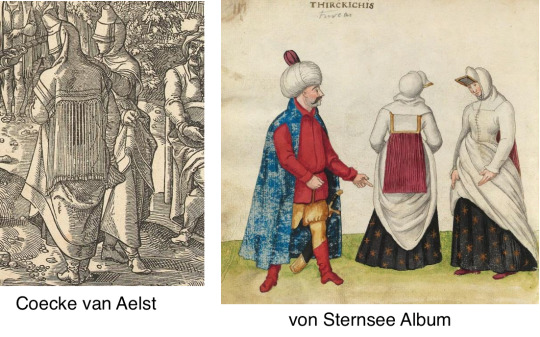
(Coecke van Aelst's woodcuts were identified as the source for the von Sternsee album's illustration in Katherine Bond's 2018 dissertation.)
Copy of a copy of what?
In spite of the problems it causes, copying from other artists' work was common in costume albums (Bond 2018). Considering that the artists did not visit all the cultures they illustrated, this is unsurprising. Some images were copied repeatedly, and the artist misunderstanding the source material wasn't the only source of distortion. Artists also made up details to compensate for bare-bones source material.
This simple line black-and-white print of an Irish woman wearing a léine (linen tunic), brat (Irish mantle), and headwear was used by several artists, all of whom made changes and additions. The first copy in this post is the most faithful to the original, but it still adds long sleeves and eyelet holes on the neckline to the léine. The coloring of the headwear suggests a wool hat crested with a tuft of horsehair and having a linen roll at the bottom. The coloring also gives the brat a contrasting lining.
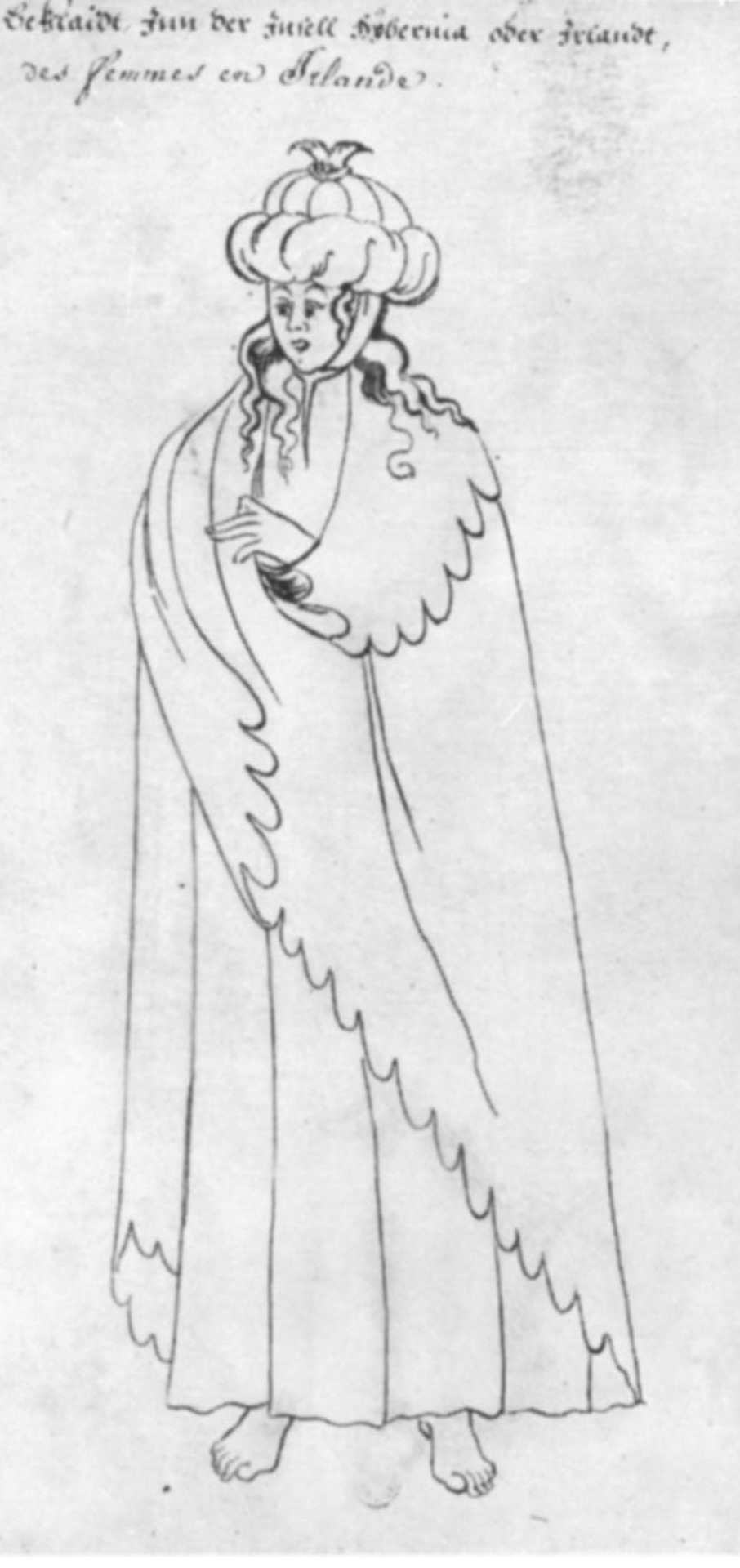

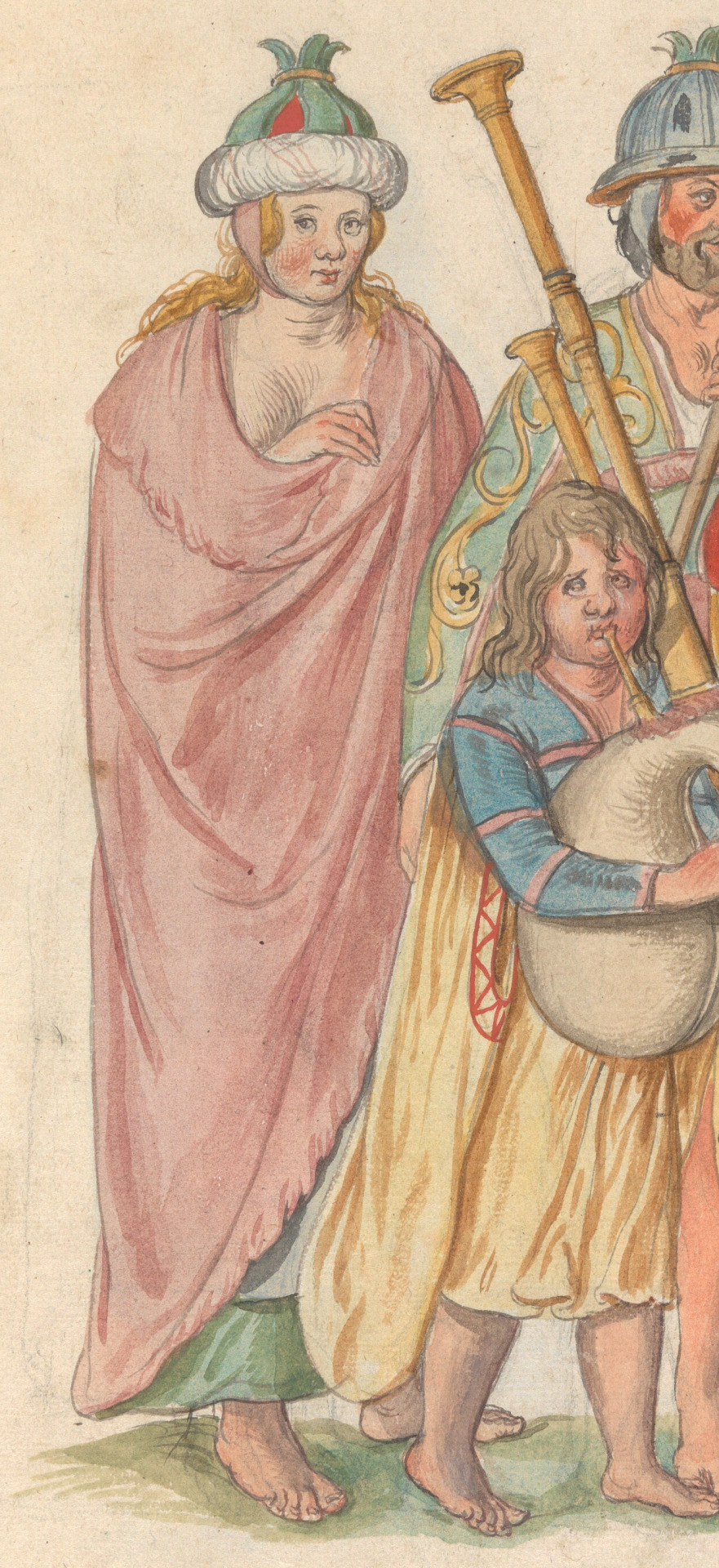

The second knockoff is the most famous. It comes from Lucas De Heere's illustration which purportedly shows Irish people in service to King Henry VIII. This is some thing De Heere couldn't have actually seen, as he moved to England 20 years after Henry VIII died and never went to Ireland at all. De Heere took the most liberties with his version. His Irish woman appears to be topless under her brat. The bottom of her léine has much less volume than the original, and De Heere has added an apron. For the hat, De Heere has replaced the crest with triangles of green wool.
Unlike De Heere's version, the final version is mostly loyal to the cut shown in the original, but it makes some unlikely suggestions for the materials. The léine appears to be green silk brocade. The brat also appears to be silk. Accounts from people who actually went to Ireland in the 16th and early 17th centuries state that these garments were made of linen and wool, respectively. Both the hat and its crest are now completely made of linen.
Chronological distortion:
The heavy use of copying in costume books also has the potential to mislead us in terms of when these fashions were worn, because the original images may be significantly older than publication year of the books that copy them. For example, the dress of Livonian women shown in Hans Weigel's 1577 book was almost certainly copied from Albrecht Dürer's 1521 watercolors. Weigel used references that were more than half a century old, but described them as if they were contemporary fashion in 1577.
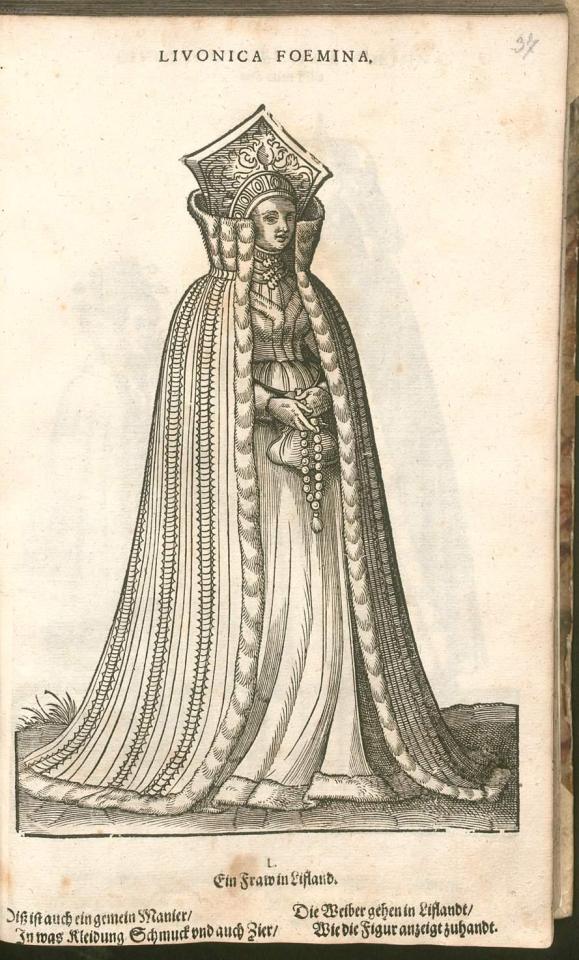
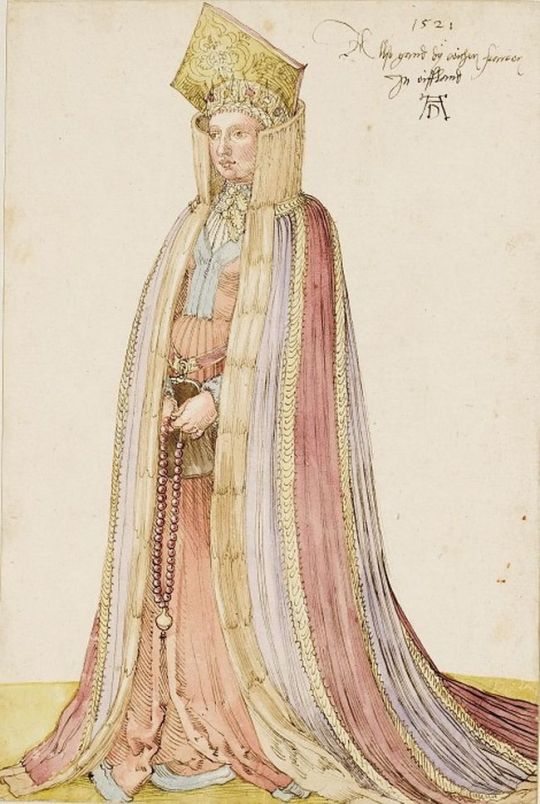
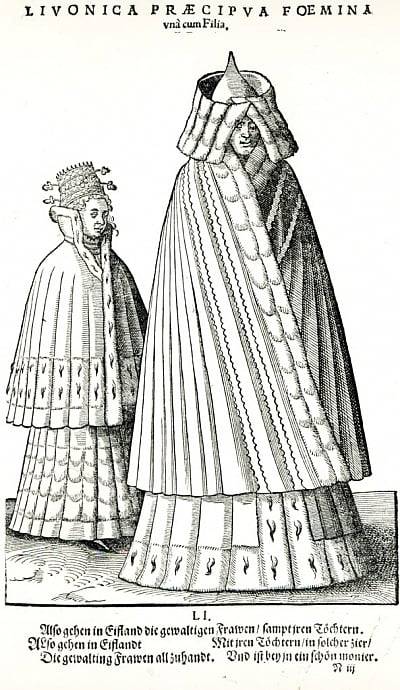
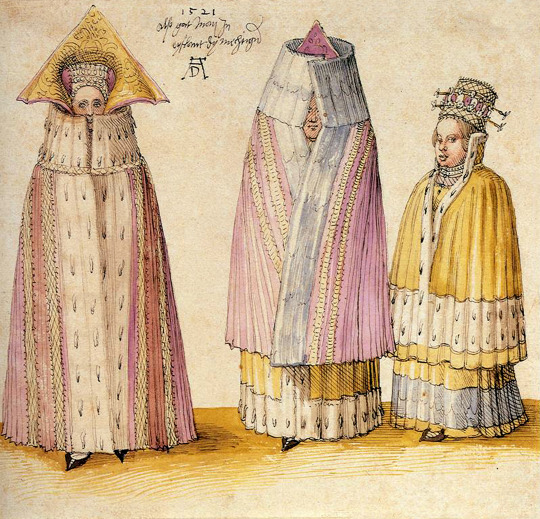
Even when costume book images are accurate portrayals of their source material, many of them lack the detail needed to identify seams, fabric types, or garment understructures. How do we deal with these problems when attempting to reconstruct what the people shown in these books actually wore?
What do we do about it?
I am not saying that we should discard these things completely as sources. Dress historians as respected as Patterns of Fashion author Janet Arnold and The Tudor Tailor authors Jane Malcolm and Ninya Mikhaila have used costume book illustrations. I definitely know less about 16th c. dress history than Jane and Ninya. I am just saying we shouldn't use them uncritically.
First, do some research on the costume book you're looking at. When was it created? Do the illustrations look suspiciously similar to those in other books? (Google image search and pinterest can be helpful for identifying this.) Did the creator, like Hans Weigel, have a particular bias they were advancing? Did they actually visit the cultures they portrayed? Christoph Weiditz actually traveled quite a bit, but he did not visit the British Isles, so his Irish and English women are probably based on someone else's art (Bond 2018). A lot of the scholarly publications about costume books are frustratingly paywalled, but some of them can be accessed for free via researchgate or academia.edu.
Avoid using copies when possible, even if the copies are more realistic-looking or more detailed art. As I discussed in the examples above, artists change things when they copy. Publication dates of copies can also be misleading in terms of dating clothing styles.
Find other sources such as: written descriptions from the time period, extant historical garments, more detailed art depicting similar fashions in related cultures, and art made by people from the culture you are studying. Period written descriptions can yield information about materials used, colors, and other details. Extant garments are your best source for information on cut and construction (unless you are lucky enough to have an extant tailor's manual from your period and culture). Detailed art depicting similar fashions can offer suggestions to fill in for missing information on construction, materials, and embellishments. Art created by the culture is valuable for identifying inaccuracies created by bigoted or ignorant artists.
Finally, remember that it's okay to not know everything. There are gaps in our knowledge about what people wore 500 years ago that will probably never be filled without a time machine. Sometimes you just have to make a plausible guess and move on. Don't let yourself get so paralyzed by doing research that you never complete the garment reconstruction/art/tumblr post you were doing the research for.
Bibliography:
Bond, K. L. (2018). Costume Albums in Charles V’s Habsburg Empire (1528-1549). https://doi.org/10.17863/CAM.25054
Dunlevy, Mairead (1989). Dress in Ireland. B. T. Batsford LTD, London.
Ilg, Ulrike. (2004). The Cultural Significance of Costume Books Sixteenth-Century Europe. In Catherine Richardson (ed.), Clothing Culture, 1350-1650 (p. 29-47). Ashgate.
McClintock, H. F. (1943). Old Irish and Highland Dress. Dundalgan Press, Dundalk.
McClintock, H. F. (1953). Some Hitherto Unpublished Pictures of Sixteenth Century Irish People, and the Costumes Appearing in Them. The Journal of the Royal Society of Antiquaries of Ireland, 83(2), 150-155. https://www.jstor.org/stable/25510871
Costume Books mentioned:
Amman, Jost. Gynaeceum, sive Theatrum mulierum.
The Costume Album of Christoph von Sternsee. not available on-line. Katherine Bond's research is your best source for this one.
Desprez, François. Recueil de la diversité des habits.
De Heere, Lucas. Corte Beschryvinghe van Engheland, Schotland, ende Irland.
Théâtre de tous les peuples et nations de la terre avec leurs habits et ornemens divers, tant anciens que modernes, diligemment depeints au naturel par Luc Dheere peintre et sculpteur Gantois.
Vecellio, Cesare, and Gratilianus, Sulstatius. Habiti antichi et moderni di tutto il Mondo di Cesare Vecellio.
Trachtenbuch des Christoph Weiditz
Weigel, Hans, and Amman, Jost. Habitus praecipuorum populorum, tam virorum quam foeminarum singulari arte depicti.
Kostüme der Männer und Frauen in Augsburg und Nürnberg, Deutschland, Europa, Orient und Afrika
Kostüme und Sittenbilder des 16. Jahrhunderts aus West- und Osteuropa, Orient, der Neuen Welt und Afrika
costume prints by an unknown artist, in the Bibliothèque nationale de France, Cabinet des Estampes. I cannot find this one online. image taken from McClintock 1953.
#dress history#historical fashion#art#16th century#17th century#historical costuming#historical dress#cw whorephobia#cw racism#irish dress#leine#irish mantle#reenactment#costume album
197 notes
·
View notes
Photo

I got the Urge to make another List! Here’s some spring and autumn fics for all your reading needs! As before @missanniewhimsy helped me make this list, and I truly appreciate the help!
Autumn
fire & smoke by raisesomehale (2k, T)
It’s not like Stiles had meant to offend Derek when they first met two days ago, he had just been surprised! Caught off guard! Unprepared.
If anything, it’s his dad’s fault.
He had been the one to suggest they hire some extra help after his accident back in May put him strictly out of commission until the new year. But back-injury or not, the cattle cabin must be rebuilt before the herd moves back into the pastures after winter, and there was no way Stiles would be able to do the work all by himself.
And so it was decided. His dad had hired Derek. And when the time finally came, sent Stiles off to fetch him from the train station, neglecting entirely to mention the small matter of the man being a fucking werewolf.
we’re still writing pages by elisela (3k, G)
Autumn is Stiles’ favorite time of the year—leaves are falling, the air is getting crisp, the whole of Market Street smells like cinnamon, and he gets to spend Saturday mornings watching his daughter tear around a football field like there’s nowhere else she’d rather be.
The Curse of the Love Sweater by HisBeloved (56k, E)
The "sweater curse" or "curse of the love sweater" is a term used by knitters to describe the belief that if a knitter gives a hand-knit sweater to a significant other, it will lead to the recipient breaking up with the knitter.
When Stiles and Derek were children, a misunderstanding created a rift between Claudia Stilinski, owner of The Hale Yarn Company, and Talia Hale, the best knitter and spinner in the county, leading to the opening of Lucky Ewe, Claudia Stilinski's yarn store.
Stiles and Derek have been lifelong competitors at the Beacon County Fair and after their mothers died, became owners of competing yarn shops. Derek is a budding knitwear designer on the eve of the release of his first book of patterns. Stiles wants him on his popular knitting YouTube show despite the decade-long feud between the Stilinski's and Hales. Hijinks, fluff, and ridiculousness ensue, and the boys get their happy ending.
Love Cake by kellerific (4k, T)
Stiles, newly home from college, shares an important family tradition with Derek.
Fallen leaves can be picked up by the shovelful by dearericbittle (3k, T)
Stiles has been working so hard to keep his magic a secret from his roommate, and it’s worked pretty well for the first month or so. And then he can’t resist playing around in the leaves and well… Apparently he’s been sharing a room with a werewolf? Suddenly this Emissary thing he’s heard about makes a lot more sense.
Like Leaves by lanalua (2k, G)
When Stiles moved to Vermont to train as an emissary, he didn't expect to fall quite so hard.
Spring
among your heart-shaped leaves by dappledawndrawn (12k, T)
After rebuilding the Hale house, Derek enlists Stiles' help in planting a garden.
It’s a Date by JoMouse (1k, G)
Roscoe breaks down in the rain on his way to surprise Derek.
Promise of Spring by Still_beating_heart (1k, T)
Spring showers bring ruined picnics and an opportunity to dance in puddles.
A peony for your thoughts by changez (2k, T)
“Don’t you dare,” Stiles hissed at the thief, waving the floral tape in as threatening of a manner as he could muster. (It was the closest object. Don’t judge.) The thief looked at Stiles as if to say: “oh yeah? Try me,” stuck his nose up in the air, and sauntered out of the shop, a rose clenched in his maw.
The Bright Side of Disaster by Gia279 (5k, T) *this is me
Tucked between fresh harvested vegetables and fruits, homemade skincare products and lovingly knit scarves and sewn shawls, were booths and tables selling potions, amulets, crystals, and herbs, athames and wands, scrying glasses and hand-embroidered altar cloths. Beacon Hills was a hotbed for magical activity, and it drew the supernatural community like moths to a flame. There were rumors that magical tools crafted in town were more powerful, potions more effective, even herbs more potent.
Barefoot in the Sand by wulfnerd (100, T)
The Stilinski-Hale goes to the beach, the water is too cold, and Stiles feels possessive.
#sterek#fic recs#rec list#spring fics#autumn fics#sterek fic recs#teen wolf#stiles stilinski#derek hale#recent recs#gardening fic#werewolves are known fic#human AU#ateez fluff#magical farmers market#flower shop au#we've got it all here
214 notes
·
View notes
Text
Origins of the Pibo: Let’s take a trip along the Silk Road.
1. Introduction to the garment:
Pibo 披帛 refers to a very thin and long shawl worn by women in ancient East Asia approximately between the 5th to 13th centuries CE. Pibo is a modern name and its historical counterpart was pei 帔. But I’ll use pibo as to not confuse it with Ming dynasty’s xiapei 霞帔 and a much shorter shawl worn in ancient times also called pei.
Below is a ceramic representation of the popular pibo.
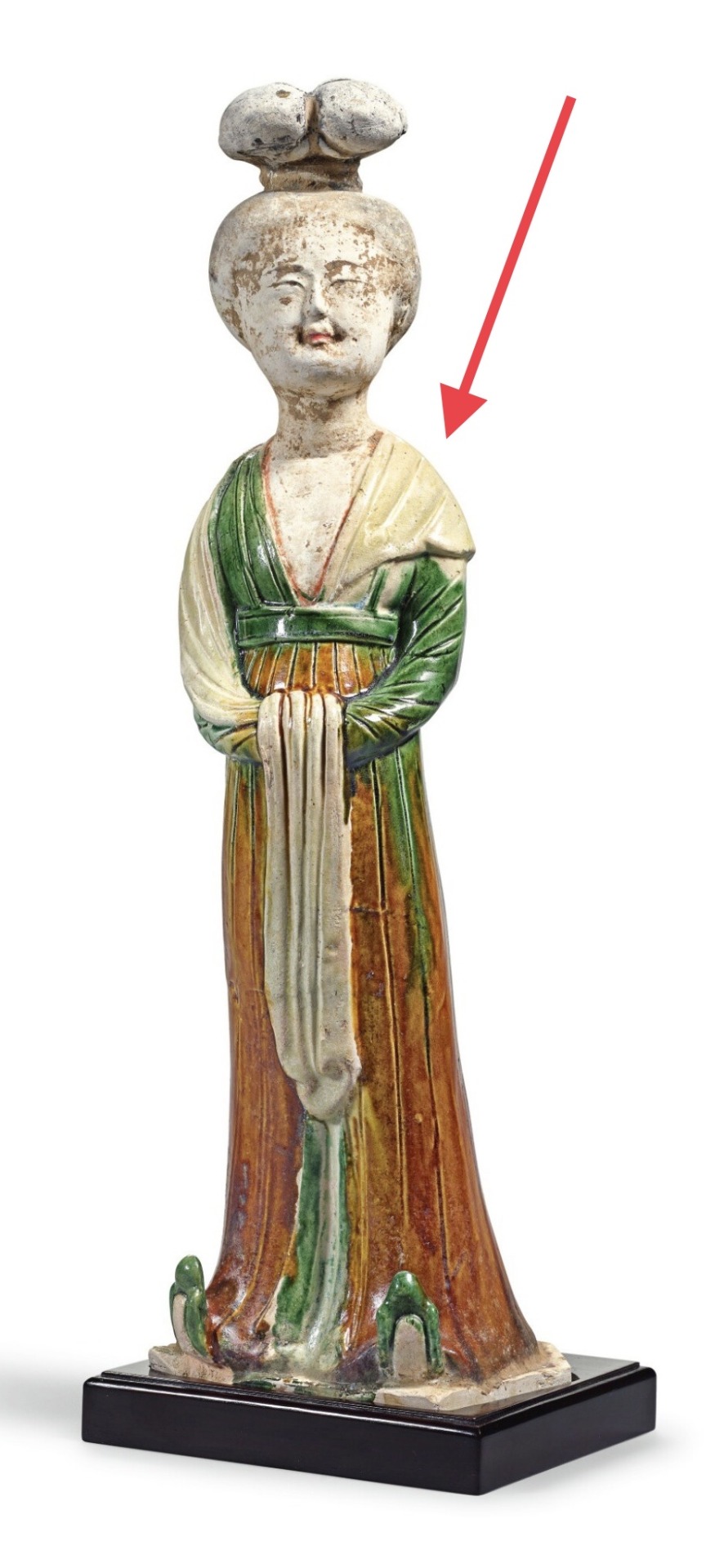
A sancai-glazed figure of a court lady, Tang Dynasty (618–690, 705–907 CE) from the Sze Yuan Tang Collection. Artist unknown. Sotheby’s [image source].
Although some internet sources claim that pibo in China can be traced as far back as the Qin (221-206 BCE) or Han (202 BCE–9 CE; 25–220 CE) dynasties, we don’t start seeing it be depicted as we know it today until the Northern and Southern dynasties period (420-589 CE). This has led to scholars placing pibo’s introduction to East Asia until after Buddhism was introduced in China. Despite the earliest art representations of the long scarf-like shawl coming from the Northern and Southern Dynasties period, the pibo reached its popularity apex in the Tang Dynasty (618–690 CE: 705–907 CE).
Academic consensus: Introduction via the Silk Road.
The definitive academic consensus is that pibo evolved from the dajin 搭巾 (a long and thin scarf) worn by Buddhist icons introduced to China via the Silk Road from West Asia.
披帛是通过丝绸之路传入中国的西亚文化, 与中国服饰发展的内因相结合而流行开来的一种"时世妆" 的形式. 沿丝绸之路所发现的披帛, 反映了丝绸贸易的活跃.
[Trans] Pibo (a long piece of cloth covering the back of the shoulders) was a popular female fashion period accessory introduced to China by West Asian cultures by way of the Silk Road and the development of Chinese costumes. The brocade scarves found along the Silk Road reflect the prosperity of the silk trade that flourished in China's past (Lu & Xu, 2015).
I want to add to the above theory my own speculation that, what the Chinese considered to be dajin, was most likely an ancient Indian garment called uttariya उत्तरीय.
2. Personal conjecture: Uttariya as a tentative origin to pibo.
In India, since Vedic times (1500-500 BCE), we see mentions in records describing women and men wearing a thin scarf-like garment called “uttariya”. It is a precursor of the now famous sari. Although the most famous depiction of uttariya is when it is wrapped around the left arm in a loop, we do have other representations where it is draped over the shoulders and cubital area (reverse of the elbow).
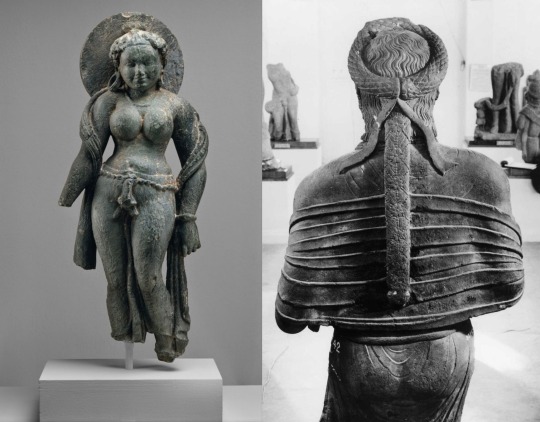
Left: Hindu sculpture “Mother Goddess (Matrika)”, mid 6th century CE, gray schist. Artist unknown. Looted from Rajasthan (Tanesara), India. Photo credit to Metropolitan Museum of Art, New York, United States [image source].
Right: Rear view of female statue possibly representing Kambojika, the Chief Queen of Mahakshatrapa Rajula, ca. 1st century CE. Artist unknown. Found in the Saptarishi Mound, Mathura, India. Government Museum, Mathura [image source].
Buddhism takes many elements from Hindu mythology, including apsaras अप्सरा (water nymphs) and gandharvas गन्धर्व (celestial musicians). The former was translated as feitian 飞天 in China. Hindu deities were depicted wearing clothes similar to what Indian people wore, among which we find uttariya, often portrayed in carvings and sculptures of flying and dancing apsaras or gods to show dynamic movement. Nevertheless, uttariya long predated Buddhism and Hinduism.
Below are carved representation of Indian apsaras and gandharvas. Notice how the uttariya are used.

Upper left: Carved relief of flying celestials (Apsara and Gandharva) in the Chalukyan style, 7th century CE, Chalukyan Dynasty (543-753 CE). Artist Unknown. Aihole, Karnataka, India. National Museum, New Delhi, India [image source]. The Chalukyan art style was very influential in early Chinese Buddhist art.
Upper right: Carved relief of flying celestials (gandharvas) from the 10th to the 12th centuries CE. Artist unknown. Karnataka, India. National Museum, New Delhi, India [image source].
Bottom: A Viyadhara (wisdom-holder; demi-god) couple, ca. 525 CE. Artist unknown. Photo taken by Nomu420 on May 10, 2014. Sondani, Mandsaur, India [image source].
Below are some of the earliest representations of flying apsaras found in the Mogao Caves, Gansu Province, China. An important pilgrimage site along the Silk Road where East and West met.
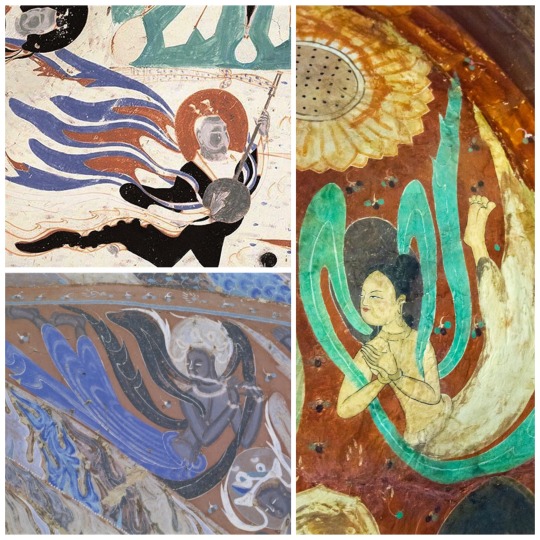
Left to right: Cave No. 461, detail of mural in the roof of the cave depicting either a flying apsara or a celestial musician. Western Wei dynasty (535–556 CE). Artist unknown. Mogao Grottoes, Dunhuang, China [image source].
Cave 285 flying apsara (feitian) in one of the Mogao Caves. Western Wei Dynasty (535–556 CE), Artist unknown. Photo taken by Keren Su for Getty Images. Mogao Grottoes, Dunhuang, China [image source].
Cave 249. Mural painting of feitian playing a flute, Western Wei Dynasty (535-556 CE). Image courtesy by Wang Kefen from The Complete Collection of Dunhuang Grottoes, Vol. 17, Paintings of Dance, The Commercial Press, Hong Kong, 2001, p. 15. Mogao Grottoes, Dunhuang, China [image source].
I theorize that it is likely that the pibo was introduced to China via Buddhism and Buddhist iconography that depicted apsaras (feitian) and other deites wearing uttariya and translated it to dajin.
3. Trickle down fashion: Buddhism’s journey to the East.
However, since Buddhism and its Indian-based fashion spread to West Asia first, to Sassanian Persians and Sogdians, it is likely that, by the time it reached the Han Chinese in the first century CE, it came with Persian and Sogdian influence. Persians’ fashion during the Sassanian Empire (224–651 CE) was influenced by Greeks (hellenization) who also had a a thin long scarf-like garment called an epliblema ἐπίβλημα, often depicted in amphora (vases) of Greek theater scenes and sculptures of deities.

Left to right: Dame Baillehache from Attica, Greece. 3rd century BCE, Hellenistic period (323-30 BCE), terracotta statuette. Photo taken by Hervé Lewandowski. Louvre Museum, Paris, France [image source].
Deatail view of amphora depicting the goddess Artemis by Athenian vase painter, Andokides, ca. 525 BCE, terracotta. Found in Vulci, Italy. Altes Museum, Berlin, Germany [image source].
Statue of a Kore (young girl), ca. 570 BCE, Archaic Period (700-480 BCE), marble. Artist unknown. Uncovered from Attica, Greece. Acropolis Museum, Athens, Greece [image source].
Detail view of Panathenaic (Olympic Games) prize amphora with lid, 363–362 BCE, Attributed to the Painter of the Wedding Procession and signed by Nikodemos, terracotta. Uncovered from Athens, Greece. J. Paul Getty Museum, Los Angeles, California, United States [image source].
Roman statue depicting Euterpe, muse of lyric poetry and music, ca. 2nd century CE, marble, Artist unknown. From the Villa of G. Cassius Longinus near Tivoli, Italy. Photo taken by Egisto Sani on March 12, 2012, Vatican Museums, Rome, Italy [image source].
Greek (or Italic) tomb mural painting from the Tomb of the Diver, ca. 470 BCE, fresco. Artist unknown. Photo taken by Floriano Rescigno. Necropolis of Paestum, Italy [image source].
Below are Iranian and Iraqi period representations of this long thin scarf.

Left to right: Closeup of ewer likely depicting a female dancer from the Sasanian Period (224–651 CE) in ancient Persia , Iran, 6th-7th century CE, silver and gilt. Artist unknown. Mary Harrsch. July 10, 2015. Arthur M. Sackler Gallery of Asian Art, Smithsonian, Washington D.C [image source].
Ewer with nude dancer probably representing a maenad, companion of Dionysus from the Sasanian Period (224–651 CE) in ancient Persia, Iran, 6th-7th century CE, silver and gilt. Artist unknown. Mary Harrsch. July 16, 2015. Arthur M. Sackler Gallery of Asian Art, Smithsonian, Washington D.C [image source].
Painting reconstructing the image of unveiled female dancers depicted in a fresco, Early Abbasid period (750-1258 CE), about 836-839 CE from Jawsaq al-Khaqani, Samarra, Iraq. Museum of Turkish and Islamic Art, Istanbul [image source].
The earliest depictions of Buddha in China, were very similar to West Asian depictions. Ever wonder why Buddha wears a long draped robe similar to a Greek himation (Romans called it toga)?
Take a look below at how much the Greeks influenced the Kushans in their art and fashion. The top left image is one of the earliest depictions of Buddha in China. Note the similarities between it and the Gandhara Buddha on the right.
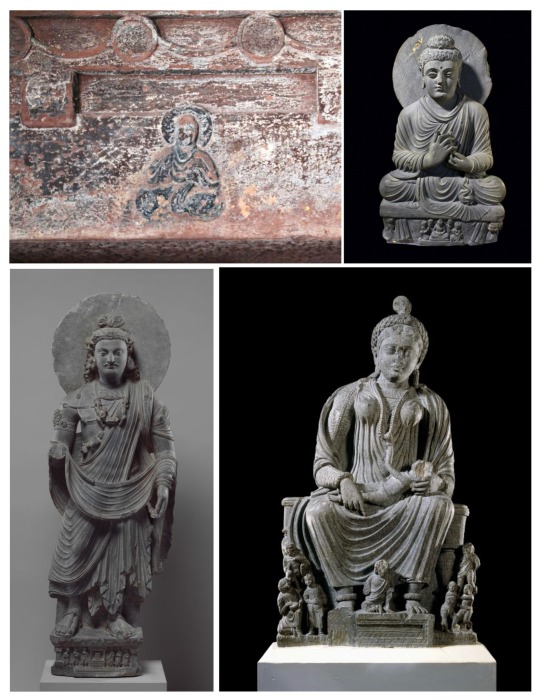
Left: Seated Buddha, Mahao Cliff Tomb, Sichuan Province, Eastern Han Dynasty, late 2nd century C.E. (photo: Gary Todd, CC0).
Right: Seated Buddha from Gandhara, Pakistan c. 2nd–3rd century C.E., Gandhara, schist (© Trustees of the British Museum)
Standing Bodhisattva Maitreya (Buddha of the Future), ca. 3rd century, gray schist. From Gandhara, Pakistan. Image credit to The Metropolitan Museum of Art, New York City, United States [image source].
Statue of seated goddess Hariti with children, ca. 2nd to 3rd centuries CE, schist. Artist unknown. From Gandhara, Pakistan. The British Museum, London, England [image source].
Before Buddhism spread outside of Northern India (birthplace), Indians never portrayed Buddha in human form.
Early Buddhist art is aniconic, meaning the Buddha is not represented in human form. Instead, Buddha is represented using symbols, such as the Bodhi tree (where he attained enlightenment), a wheel (symbolic of Dharma or the Wheel of Law), and a parasol (symbolic of the Buddha’s royal background), just to name a few. […] One of the earliest images [of Buddha in China] is a carving of a seated Buddha wearing a Gandharan-style robe discovered in a tomb dated to the late 2nd century C.E. (Eastern Han) in Sichuan province. Ancient Gandhara (located in present-day Afghanistan, Pakistan, and northwest India) was a major center for the production of Buddhist sculpture under Kushan patronage. The Kushans occupied portions of present-day Afghanistan, Pakistan, and North India from the 1st through the 3rd centuries and were the first to depict the Buddha in human form. Gandharan sculpture combined local Greco-Roman styles with Indian and steppe influences (Chaffin, 2022).
In the Mogao Caves, which contain some of the earliest Buddhist mural paintings in China, we see how initial Chinese Buddhist art depicted Indian fashion as opposed to the later hanfu-inspired garments.

Left to right: Cave 285, detail of wall painting, Western Wei dynasty (535–556 CE). Mogao Grottoes, Dunhuang, China. Courtesy the Dunhuang Academy [image source]. Note the clothes the man is wearing. It looks very similar to a lungi (a long men’s skirt).
Photo of Indian man sitting next to closed store wearing shirt, scarf, lungi and slippers. Paul Prescott. February 20, 2015. Varanasi, India [image source].
Cave 285, mural depiction of worshipping bodhisattvas, 6th century CE, Wei Dynasty (535-556 A.D.), Unknown artist. Mogao Grottoes, Dunhuang, China. Notice the half bow on his hips. That is a common style of tying patka (also known as pataka; cloth sashes) that we see throughout Indian history. Many of early Chinese Buddhist paintings feature it, including the ones at Mogao Caves.
Indian relief of Ashoka wearing dhoti and patka, ca. 1st century BC, Unknown artist. From the Amaravathi village, Guntur district, Andhra Pradesh, India. Currently at the Guimet Museum, Paris [image source].
Cave 263. Mural showing underlying painting, Northern Wei Dynasty (386–535 CE). Artist Unknown. Picture taken November 29, 2011, Mogao Grottoes, Dunhuang, China [image source]. Note the pants that look to be dhoti.
Comparison photo of modern dhoti advertisement from Etsy [image source].
Spread of Buddhism to East Asia.

Map depicting the spread of Buddhism from Northern India to the rest of Asia. Gunawan Kartapranata. January 31, 2014 [image source]. Note how Mahayana Buddhism arrived to China after passing through Kushan, Bactrean, and nomadic steppe lands, absorbing elements of each culture along the way.
Wealthy Buddhist female patrons emulated the fantasy fashion worn by apsaras, specifically, the uttariya/dajin and adopted it as an everyday component of their fashion.

Cave 285. feitian mural painting on the west wall, Western Wei Dynasty (535–556 CE). Artist unknown. Mogao Grottoes, Dunhuang, China [image source].
Cave 285. Detail view of offering bodhisattvas (bodhisattvas making offers to Buddha) next to the phoenix chariot on the Western wall of the cave. Western Wei Dynasty (535–556 CE). Artist unknown. Mogao Grottoes, Dunhuang, China [image source].
Cave 61 Khotanese (from the kingdom of Khotan 于阗 [56–1006 CE]) donor ladies, ca. 10th century CE, Five Dynasties period (907 to 979 CE). Artist unknown. Picture scanned from Zhang Weiwen’s Les oeuvres remarquables de l'art de Dunhuang, 2007, p. 128. Uploaded to Wikimedia Commons on October 11, 2012 by Ismoon. Mogao Grottoes, Dunhuang, China [image source].
Detail view of Ladies Adorning Their Hair with Flowers 簪花仕女图, late 8th to early 9th century CE, handscroll, ink and color on silk, Zhou Fang 周昉 (730-800 AD). Liaoning Provincial Museum, Shenyang, China [image source].
Therefore, the theory I propose of how the pibo entered East Asia is:
India —> Greek influenced West Asia (Sassanian Persians, Sogdians, Kushans, etc…) —> Han China —> Rest of East Asia (Three Kingdoms Korea, Asuka Japan, etc…)
Thus, the most likely theory, in my person opinion, is Buddhist iconography depicting uttariya encountered Greek-influenced West Asian Persian, Sogdian, and Kushan shawls, which combined arrived to China but wouldn’t become commonplace there until the explosion in popularity of Buddhism from the periods of Northern and Southern Dynasties to Song.
References:
盧秀文; 徐會貞. 《披帛與絲路文化交流》 [The brocade scarf and the cultural exchanges along the Silk Road]. 敦煌研究 (中國: 敦煌研究編輯部). 2015-06: 22 – 29. ISSN 1000-4106.
#hanfu#chinese culture#chinese history#buddhism#persian#sogdian#kushan#gandhara#indian fashion#uttariya#pibo#history#asian culture#asian art#asian history#asian fashion#east asia#south asia#india#pakistan#iraq#afghanistan#sassanian#silk road#fashion history#tang dynasty#eastern han dynasty#cultural exchange#greek fashion#mogao caves
296 notes
·
View notes
Text




Here are 4 of my attacks for this year's Art Fight! I had a lot of fun this year and I'm proud of all of these. :3 We have Oyakoyi for @american-neurotypical , Verity for @collabwithmyself , Dune and Joyce for @moonknightproductions , and Kingdom Key and Kingdom Key D for @tharkflark1 .
[ID: 4 digital drawings. The first is of Oyakoyi the demon. He mostly has red skin, black fingers, a red and black tail, and red and black horns. She has long dark brown hair, yellow eyes, a pointed yellow tongue that sticks out, and dark hair on its belly. It wears a black leather bra, jean shorts, eyeball necklace, and striped arm socks. He sits on a pink bench with his left foot on the ground and the other on the bench. They rest its right eblow on their raised knee and make a peace sign.
Second drawing is of Verity, a disabled human lawyer. Star has brown skin, curly brown hair that covers stars left eye, a wide nose, dark eyes, and body hair. Star wears a purple headband, purple turtleneck, purple and tan shawl, and tan pants. Star has a rollator that is purple and tan. Verity stands behind stars rollator, left hand holding one handle, right hand up and pointing to something offscreen, a determined expression on stars face. The background is lilac purple with a pattern of glowing yellow stars.
Third drawing is of Dune and Joyce, two ocs for the games Journey and Abzu respectively. It's in a lineless style and shows them from the chest up. Dune is on the left. They have a black oval head with white eyes narrowed in annoyance. They wear a dark yellow headband, a dark red caped robe, and dark red and gold scarf. Joyce stands next to them. They have navy blue skin and big almond eyes slightly squinted in happiness. They wear a diving suit the same color as their skin with yellow accents, as well as a yellow helmet with white horns on top and blue horns on the sides. Dune's scarf is wrapped around Joyce's shoulders, and Joyce holds onto the end with one hand.
Fourth drawing is of Kingdom Key and Kingdom Key D, gijinkas of the keys from Kingdom Hearts. On the left is KK, who has gray skin, blue eyes, and spiky blonde hair that covers one eye and has a single side braid. Next to him is KKD, who has bronze skin, red eyes, and gray hair in the same style as KK's. KK has an arm around KKD's shoulders and an open mouthed grin, while KKD looks back at them with an expression that looks like :T . They both wear black long sleeved shirts and small brown scarves. The background is split diagonally in two, one half blue and the other red. End ID]
16 notes
·
View notes
Text

VB-FL08 Gray Floral Pattern with Tassels Fashion Scarf
Visit: Virginia Blossoms
#women's fashion#long shawl scarves#long shawl scarve for women#long shawl scarves for girls#virginia blossoms
0 notes
Note
I'm a long time knitter thinking about getting into spinning (probably not soon bc I live in a tiny apartment and barely have room for my knitting stuff), but I'm curious: what do you do with your handspun yarn? Do you ever spin enough to make a larger project like a sweater? (That's mostly what I like to knit)
one of the cool things about handspun is that you can literally make anything out of it!
i personally have made socks, shawls, hats, mittens, scarves, and—once—a baby sweater, but not an adult sweater. (yet.) this is for a couple reasons, though.
first, i'm fat. i'm not especially fussed about it, but it does mean that just from a coverage perspective, my 53"/135 cm bust is going to need a lot more yarn than someone with a 35"/89cm bust.
the second reason complicates the first: i really don't like knitting with worsted-and-heavier yarns. i'm currently working on a jumper that has 4.75 stitches to the inch, and i am suffering because i hate how big everything is. so spinning for a jumper for myself means probably 2000 metres of sock weight. which, don't get me wrong, would be fun, but this brings me to:
the third (and biggest) reason, which is that i'm disabled, and for a lot of years i had to really limit how much spinning i could do because my damaged hips couldn't bear the motion of treadling. for probably ten years, i didn't spin more than 100g of anything, because even doing that much could take me a month or more of regular spinning sessions.
that said, reason the third has been largely mitigated by my eel wheel, so i've actually been thinking about trying to spin for a sweater this year! my personal physical issues made spinning really hard for a while, but generally speaking, there's absolutely no reason you can't spin for a sweater, and there are quite a few people around here who've done so with beautiful results.
i will say, with regards to spinning, that it's a remarkably forgiving craft with regards to space. i cleaned out my nightstand the other day and discovered four spindles and 50g of fibre in it—i hadn't even realised they were in there! spinning supplies can be really tiny, so it's actually a great choice for small spaces. a drop spindle and some fibre will fit almost anywhere you want them to, so space doesn't have to be a huge concern if you don't want it to be. i hope you give it a go!
39 notes
·
View notes
Text

It's Wednesday My Dudes

Chugging along with my evenstar (Shawl 14). If I look at it from this specific angle I can pretend that it's finished and I don't have another month and a half of daily knitting left on it. Also the edging curls a LOT and I know that it'll block out fine but my brain makes all nervous juice all the time so I'm Worried about it. I do NOT want to reach the end of a project that took me almost a year and be disappointed (the gauge swatch blocked perfectly flat it's going to be fine).

Speaking of things that are flat. My new scarf is! (Shawl? It's technically a shawl but I have so many shawls I'm calling it uhhh Scarf 5 (i have no idea how many scarves I've knit)) I started with 6 increases every other row which was resulting in a 3/4ths of a pie shape. but I want something more crescent? So I added another increase section on each side (for 8 every other row) and I'm gonna give it another 5 or so inches and see if I wanna add another one.

Finally this little guy, Doily 14. Who desperately wants to go on longer needles. I'm pretty close to finishing chart A of this guy and moving on to chart B. Which is basically seamless from A except it's printed at half the size because the rows are just That Long. Still, this is pretty easy for a Neibling pattern (or I've knit so many I've gotten used to them?), it's making me crave something Hard. I think I might put one of his big boy table clothes on my to-make list for after I finish this and my Evenstar.
#knitting#knitblr#lace rot#wip#wip wednesday#project: shawl 14#project: scarf 5#project: doily 14#wishing once again i could have another set of hands so I can get more done (and play vidya games while knitting)#i've been having a major case of cast-onitus but there's literally not enough time in the day for all the projects i wanna make rn
26 notes
·
View notes
Note
random question (but i think you're bery smart and i would love your advice /opinion about this):
a lot of my friends are getting married and i am struggling a lot because i tried to wear dresses and i don't feel comfortable with them.
i think that it could help if i found the dresses interesting or fascinating. My ex is from Kolkata and she always shares with me all those beautiful saree and I ADORE THEM.
So an idea struck me: what if I wore a saree? I love them and I would feel safe because they remind me of my ex whom i still love and adore to this day.
But...would it be right to do that? I feel like I would be disrespectful since I don't really know the traditions or the culture that well.
What do you think?
I can't speak for all south asians, but I don't think it's offensive at all.
For eg, I think it would be offensive if I, as a non-muslim, wore an abaya, because it's not a costume you can try on. But I did cover my head with a shawl when I went to the mosques in Pakistan. So, it's about knowing what is respectful and what is not.
There are certain clothes, accessories, and jewelry in our culture that are not okay for other people to wear because they have religious significance. But I don't think it's the same for a saree.
In Sri Lanka, we love it when other people (including those from different ethnicities) wear our cultural clothes.
There are different ways to wear sarees depending on your ethnicity.
For eg, how a tamil person wears it (traditionally):

This is how a sinhalese person wears it traditionally

you can see the difference near the waist, blouse, and pleats.
what we (and any culture) would consider offensive is when other cultures take ownership of your own and try to erase it. For eg, there was a whole thing on tiktok/insta recently where some white women were discovering desi dupattas (shawls) and calling them 'bohemian chic/scandinavian scarves) - which pissed people off (rightfully so).
I think it's totally fine for you to wear a saree as long you call it what it is :)
I hope you find some beautiful sarees to wear for the wedding. There are so many different styles and fabrics and designs. I'm sure you will find something that makes you feel comfortable <3
8 notes
·
View notes
Note
Modest!Alicent:
There's also something Southern about it all. She's of Andal decent (pale) and from Oldtown (southernmost part of Westeros). Oldtowners like her should be covering up to protect themselves from the sun. It makes sense for modest dress and veils to be most prominent/popular there, out of the whole country.
yes yes yes this.
her modesty has so many layers in my mind, like
A) it's about her religion, it's about her faith and how she connects to and honors her gods.
B) it's about keeping some of herself, to herself, and those she trusts. it's about control. it's about feeling safe and clean and modest and safe from stares and touches and lust. it's about reclaiming even just a piece of herself for no one but her.
C) It's about holding onto a bit of her home, her mother, her house. it's about staying connected to Oldtown and the Vale and her people, her family. it's something she can give to her daughter, that her children can give to their children.
like it's layered and tragic and beautiful and it's so so her.
I think she loves going back to Oldtown, it's never as often as she would like, but she loves to go back and see all the women with veils and long skirts, out living their lives. she loves getting to go around and compliment other girls veils or intricate undergarments that covers their arms when it's too hot for long sleeves, it makes her feels young and home and safe again.
she finds an excuse to tour the market so she can bring home new veils, one's she picked, made by her people, the ones she wore when she was young.
its like a breath of fresh air.
she brings Helaena with her, and typically the boys and Criston join her, she places scarves and shawls over them, tickles them with the corners of silk scarves, lets them pick some for her.
even the men in Oldtown cover up more than those in Kings Landing do, so the boys ask to match with them, and they have a day spent out in the son like she had when she was young. she sees her daughter running in her long skirt, chasing after the boys, donned in high patterned socks and half rolled up sleeves, with some bug or another, veil flapping in the wind. she leans against Criston, who's making sure the wind doesn't blow her own veil away even though she's assured him time and time again she pins her veils very well. she watches her children live her childhood and its just so nice.
I just think she'd be so relieved to be able to take this little piece of her home back to the Keep.
#modesty#modest alicent hightower#modest!alicent hightower#house of the dragon#alicent hightower#hotd#aegon ii targaryen#pro team green#aegon targaryen#aemond targaryen#helaena targaryen#criston cole#pro alicent hightower#she's living her best life#turned into a little ficlet near the bottom cause I was just going with the flow#sorry this took so long. my brains been a mushy pile of useless lately lol
94 notes
·
View notes